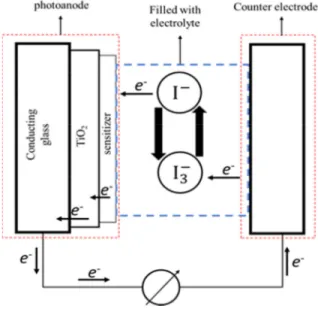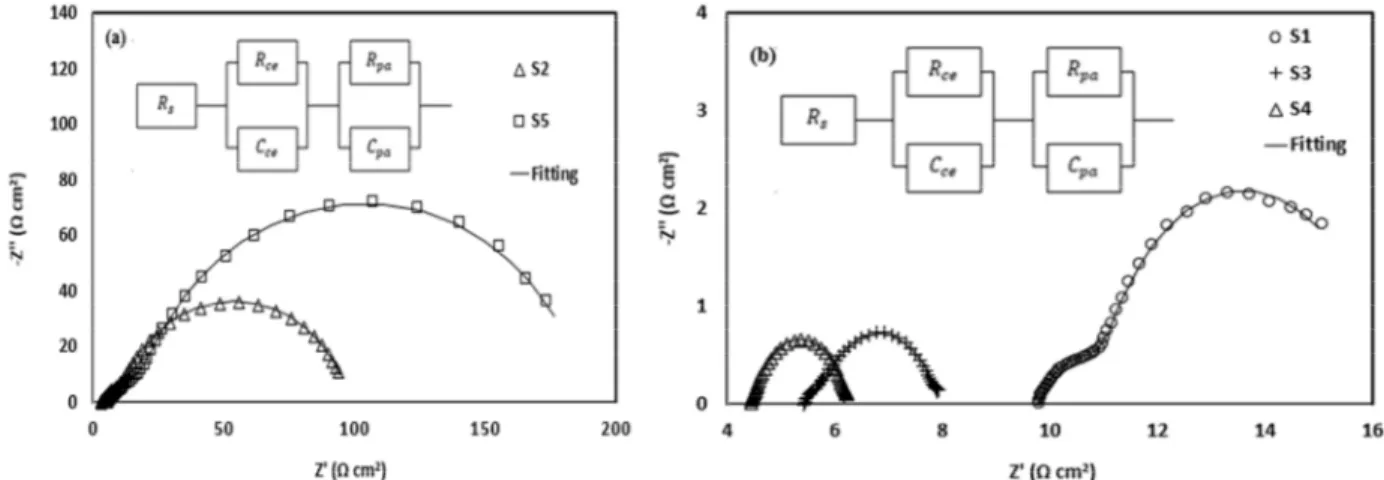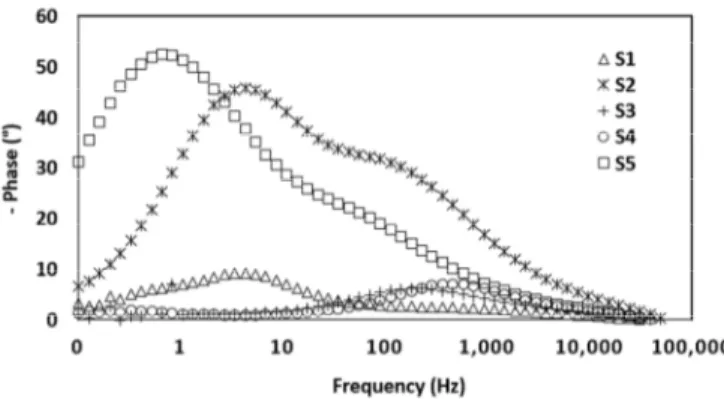ScienceDirect
Materials Today: Proceedings 17 (2019) 394–400 www.materialstoday.com/proceedings
2214-7853© 2019 Elsevier Ltd. All rights reserved.
Selection and Peer-review under responsibility of 6th International Conference on Functional Materials & Devices 2017 (ICFMD 2017).
6th International Conference on Functional Materials & Devices (ICFMD 2017)
Study of some sensitizers for gel polymer electrolyte based
sensitized solar cells (SSCs)
M.A. Mingsukang
a, S.N. Hisamuddin
a, N.N.S. Baharun
a,
Y.C. Lee
a, Z.H.Z. Abidin
a, M.H. Buraidah
a*, A. Karakas
baCentre for Ionics University of Malaya, Department of Physics, Faculty of Science, University of Malaya, 50603, Kuala Lumpur, Malaysia bDepartment of Physics, Faculty of Sciences, Selcuk University, Campus, Konya, Turkey
Abstract
The performance of phthaloychitosan gel polymer electrolyte (GPE) based sensitized solar cells (SSCs) fabricated with different types of sensitizer have been studied in this work. Five types of sensitizer were used viz., curcumin, chlorophyll, (E)-4-hydroxyl-3-((4-iodophenyl)diazenyl)-2H-chromen-2-one (CAD5), (E)-4-hydroxyl-3-((4-methoxyphenyl) diazenyl)-2H-chromen-2-one (CAD7) and cadmium sulphide (CdS). These sensitizers were designated as S1, S2, S3, S4 and S5 respectively. The performance of the sensitized solar cells (SSCs) has been characterized and the experimental results showed that S1 (SSC fabricated with curcumin dye sensitizer) exhibits the best performance with short circuit current density (Jsc) of 3.18 mA cm-2, open circuit voltage (Voc) of 0.41 V, fill factor (FF) 0.57 and power conversion efficiency (PCE) of 0.73%.
© 2019 Elsevier Ltd. All rights reserved.
Selection and Peer-review under responsibility of 6th International Conference on Functional Materials & Devices 2017 (ICFMD 2017).
Keywords: Sensitized solar cells; Sensitizers; Gel polymer electrolyte; Electrochemical impedance spectroscopy
1. Introduction
Electricity is important in today’s world. At present fossil fuel and charcoal are the main sources of energy to produce electricity [1]. It is estimated that the world’s population will increase in the future and a lot more energy will be needed. Such dependency on fossil fuels can lead to global energy problem such as increase in energy
* Corresponding author. Tel.: +60379677140. E-mail address: mhburaidah@um.edu.my
demand, gradual depletion of fossil fuels and also environmental issues due to combustion of fossil fuels [2]. These problems can be overcome if alternative renewable green energies can be made available. Solar energy is among the renewable energy source that can be used to minimize the problems. Solar cells are devices that convert energy from sunlight into electricity.
Typical SSCs are made up of photoanode, electrolyte and counter electrode as shown in Fig. 1 [3]. Photoanode is the component responsible for light absorption. It consists of a transparent conducting glass on top of which is deposited two layers of titanium dioxide (TiO2). The first layer is a blocking layer made up of TiO2 of size smaller
than the TiO2 size forming the second layer. The second layer is porous. The porosity of the second layer enable
more loading of the dye due to its larger surface area. The counter electrode acts as the electron collector and the electrolyte acts as the electron transporting medium from the counter electrode to the photoanode via the redox mediator.
When the light reaches the photoanode, it will excite the sensitizer deposited on the surface of TiO2 layer. Excited
sensitizers inject electrons into the conduction band of TiO2. Electrons will flow through the external circuit to the
counter electrode and flow back into photoanode through redox mediator ions. As the sensitizers inject electron, it is said to be oxidised (lose an electron). The oxidised sensitizers will receive electron from which reduced the sensitizer back to its original form. In this process, transforms into (oxidation). The electrons that reached the counter electrode from external circuit will be collected by ions (reduction) and it will transform back to the ions.
Fig. 1. This figure shows the illustration n of SSC.
In this work, five different types of sensitizer viz., curcumin, chlorophyll, (E)-4-hydroxyl-3-((4-iodophenyl)one (CAD5), (E)-4-hydroxyl-3-((4-methoxyphenyl) diazenyl)-2H-chromen-2-one (CAD7) and cadmium sulphide (CdS) are employed. These are designated as S1, S2, S3, S4 and S5 respectively. S1 and S2 are natural sensitizers that have been extracted from Tumeric and Cassia alata leaves respectively. S3 and S4 are synthetic sensitizers that were prepared by dissolving dye pigments in an extracting agent (ethanol) and S5 is an inorganic quantum dot (QD) sensitizer. The electrolyte used for every cell is based on our previous study [4] which utilized phthaloychitosan based GPE and the counter electrode used is platinum (Pt).
2. Research methodology
2.1. Preparation of GPE
Phthaloylchitosan (PhCh) and polyethylene oxide (PEO) were added to the liquid electrolyte containing tetrapropylammonium iodide (TPAI), ethylene carbonate (EC) and dimethylformamide (DMF) with fixed composition (PhCh = 5.51 wt.%, PEO = 1.29 wt.%, EC = 32.22 wt.%, DMF = 38.66 wt.% and TPAI = 22.7 wt.%). Iodine crystal (7.5% from amount of TPAI) was added to obtain redox couple in GPE system. Ionic liquid 1-butyl-3-methylimidazolium iodide (BMII) was added (8 wt.%) to improve its ionic conductivity.
2.2. Deposition TiO2 layers to the photoanode
The photoanode was prepared on a fluorine tin oxide (FTO) glass substrate. Two layers of TiO2 were deposited
onto the FTO glass. The first layer was prepared by spin coat the TiO2 solution that comprised 0.5 g TiO2 (14 nm
size) powder and 2 mL HNO3 (pH=1) followed by sintered at 450°C for 30 min to form a blocking or compact layer.
The electron recombination with the redox ions in the electrolyte of the DSSC was prevented by minimizing contact between the electrolyte and conductive substrate surface via compact layer [5, 6]. Second layer of TiO2 paste that
comprised 0.5 g TiO2 (21 nm size) powder mixed with 2 mL HNO3 (pH=1), 0.25 g polyethylene glycol (PEG) and 2
drops of surfactant was prepared. This mixture was coated on top of the compact layer by doctor blade method. The mesoporous layer of TiO2 on top of the compact layer was then formed by sintered at 450 °C for 30 min.
2.3. Deposition natural dye sensitizers to the photoanode with TiO2 layers
Curcumin and chlorophyll were extracted from Turmeric and Cassia alata leaves. The turmeric was sliced paper-thin (~0.15 cm) and dried for 24 h at room temperature. The Cassia alata leaves were dried for 24 h at room temperature before its edges were cut. Drying process is to ensure that only the dye pigment left. Both dried Turmeric and Cassia alata leaves were soaked in ethanol separately with ratio 1 g of moiety to 10 mL ethanol for 24 h in a dark environment for the colour to dissolve. The solution was then filtered to remove the solid residues. The FTO/compact layer/mesoporous layer assembly was then soaked in the curcumin and chlorophyll sensitizer solution for 24 h.
2.4. Depositing synthetic sensitizers to the photoanode with TiO2 layers
Coumarin-Azo synthetic dyes were utilized in this work. The solution containing CAD 5 and CAD 7 dyes were prepared by mixing 0.02 g of (E)-4-hydroxy-3-((4-iodophenyl)diazenyl)-2H-chromen-2-one pigment in 20.0 g of ethanol. Another batch of 20.0 g ethanol will be mixed to 0.02 g of (E)-4-hydroxy-3-((4-methoxyphenyl)diazenyl)-2H-chromen-2-one pigment. These solutions were used to soak the FTO/compact layer/mesoporous layer assembly. 2.5. Depositing inorganic QD sensitizers to the photoanode with TiO2 layers
Deposition of CdS QDs to the photoanode has been done using the successive ionic layer absorption and reaction (SILAR) method. The TiO2 photoanode was soaked in 0.1M of cadmium nitrate, Cd(NO3)2 for 60 s and followed by
0.1M of sodium Sulphide, Na2S for another 60 s. 2.6. Sensitized solar cell (SSC) fabrication
Phthaloylchitosan based gel polymer electrolyte was spread on top of the photoanode and sandwiched between the photoanode and Pt counter electrode. The active area of the SSCs was set as 0.196 cm2.
3. Results and discussion
To evaluate the performance of the SSCs fabricated with different sensitizers, the current density–voltage characteristics and electrochemical impedance spectroscopy have been done.
3.1. Current density–voltage (J–V) characteristics
Fig. 2 shows the J–V characteristics of SSCs with phthaloylchitosan based GPE having five different sensitizers. The values of Jsc, Voc were obtained from the J–V characteristics while FF and PCE were calculated using equations (1) and (2) respectively.
(1) 100 100 (2) where Jmax is current density at maximum power output and Vmax is voltage at maximum power output. The values are summarized in Table 1.
Fig. 2. J–V curves for SSCs fabricated with five different sensitizers.
Table 1. Performance parameters obtained from J–V characteristic of SSCs fabricated with S1, S2, S3, S4 and S5 sensitizers. This table also shows the series resistance (Rs) and shunt resistance (Rsh) of each SSC calculated from the J–V curves. SSCs Jsc (mA cm-2) Voc (10-1 V) FF PCE (%) Rs (102 Ω cm2) Rsh ((kΩ cm2) S1 3.18 ± 0.24 4.07 ± 0.25 0.57 ± 0.04 0.73 ± 0.03 0.36 ± 0.04 1.66 ± 0.30 S2 0.96 ± 0.05 3.13 ± 0.04 0.55 ± 0.02 0.18 ± 0.02 0.99 ± 0.14 2.46 ± 0.29 S3 0.52 ± 0.08 3.78 ± 0.35 0.59 ± 0.05 0.11 ± 0.02 1.60 ± 0.29 8.52 ± 2.57 S4 0.23 ± 0.05 2.90 ± 0.59 0.54 ± 0.06 0.03 ± 0.01 3.43 ± 1.18 5.52 ± 3.88 S5 1.53 ± 0.25 6.52 ± 0.19 0.42 ± 0.07 0.41 ± 0.05 2.59 ± 0.23 0.54 ± 0.07
The performance of the five SSCs can be understood from Table 1. S1 exhibits the highest Jsc of 3.18 mA cm-2 and highest PCE of 0.73%. This may be caused by the presence of functional groups of hydroxyl (O-H) and carbonyl (C=O) in the sensitizer’s molecular structure that helps sensitizers to bind to TiO2 film surface thus enable
the excited electron to transfer to conduction band of TiO2 efficiently [4, 7, 8]. In addition, S1 possessed the lowest
However, SSCs with S2 sensitizers did not offer high PCE as chlorophyll do not have O-H group in its structure thus lowering its ability to adsorb to the TiO2 surface and lowering its cell performance [10]. Performance of SSC with
S2 sensitizer showed a very low performance compared to the study done by Hassan et al. [10] which acquired an excellent performance (1.77% PCE, 4.59 mA cm-2 J
sc, 0.61 V Voc and 0.64 FF) of chlorophyll sensitizer-based SSC. The GPE utilized by Hassan et al. is a single salt system electrolyte which comprised polyvinyl alcohol (PVA) as the host polymer and ion contributor is potassium iodide (KI).
The SSCs fabricated with synthetic dye sensitizer i.e. S3 and S4 exhibit low performance which may due to its simple molecular structure and lack of functional groups. These two synthetic sensitizers are found to be poor sensitizers because of weak binding energy with TiO2 film and the rate of electrons injection from sensitizers to the
conduction band gap of TiO2 is low in whole visible region [11].
S5 (CdS QDs) is inorganic nano sized semiconductor sensitizer which the deposition to the surface of the TiO2
involving the ionic bonding of the ions. Theoretically, inorganic sensitizers will give better performance of the SSCs. However, in this research work the iodide-based electrolyte used is not suitable as it can cause corrosion to the CdS [12]. Corrosion of sensitizers will affect the rate of electrons transfer and will give low performance.
3.2. Electrochemical impedance spectroscopy (EIS)
The SSCs fabricated with different sensitizer are further investigate by using EIS. EIS measurement is used to study the interfacial resistance between electrolyte and electrodes. Typical Nyquist plot of SSCs consists of three semicircles. The first semicircle is in high frequency region, its corresponds on electrolyte and counter electrode interface property. Second semicircle is in mid-frequency region, associate with electrolyte and photoanode interface property while third semicircle corresponds to diffusion in the electrolyte. However, the Nyquist plots obtained in this work only consist of two semicircles from high and medium frequency region. Fig. 3 shows the Nyquist plot obtained from the SSCs fabricated with different sensitizers and the inset is the equivalent circuit to the plots. Fig. 4 shows the bode plots of the SSCs with different sensitizer for the τ calculation [13].
Fig. 3. This figure shows the Nyquist plot obtained from EIS measurement of SSCs fabricated with different sensitizers. (a) shows the Nyquist plots of S2 and S5 and (b) shows the Nyquist plots of S1, S3 and S4. Rs is series resistance, Rce and Cce are interfacial resistance and capacitance at
counter electrode/electrolyte interface and Rpa and Cpa are the interfacial resistance and capacitance at photoanode/electrolyte interface respectively.
Fig. 4. Bode plots for the calculation of τ of the SSCs with different sensitizers.
The interfacial parameters obtained from Nyquist plot are listed in Table 2. In this work, the process that occurs at the interface of photoanode/electrolyte are focused since various sensitizers were used in the SSCs. The high values of Rpa come from S2 and S5 manifest that the electron transfer at interface of photoanode/electrolyte is difficult due to the high resistance which resulted in the low SSCs. In S3 and S4 cases, they showed a very low Rpa which will result in the high rate of electron recombination. This also can be seen in lower τ values of SSCs fabricated with S3 and S4 sensitizers. Lower τ value indicated that the electron recombination process will easily occur resulting in lower Jsc of the devices [14].
Table 2. This table list the interfacial parameters obtained from Nyquist plot.
SSCs Rs (Ω cm2) Rpa (Ω cm2) τ (ms) S1 9.79 5.19 36.00 S2 3.65 78.50 58.00 S3 5.43 2.22 0.87 S4 4.47 1.64 0.43 S5 5.81 166.00 235.41 4. Conclusions
Among the five sensitizers being studied, the best sensitizer is a curcumin dye extracted from turmeric plant. SSCs fabricated with curcumin dye resulted in the outstanding performance in J–V characteristic. The best performance is due to the presence of OH group in molecular structure of curcumin that responsible for the attachment of the sensitizer to the TiO2 layer. In addition, EIS measurement revealed the good interfacial properties
at interface of photoanode/electrolyte.
Acknowledgements
The authors gratefully acknowledge the financial support from Ministry of Higher Education (Fundamental Research Grant Scheme project no. FP053–2016) and Frontier Research Grant University of Malaya (grant no. FG029-17AFR).
References
[1] S.C. Bhatia, in:S.C. Bhatia (Ed.) Advanced Renewable Energy Systems, Woodhead Publishing, India, 2014, pp. 1-31. [2] A. Błaszczyk, Dyes and Pigments 149 (2018) 707-718.
[3] B. O'Regan, M. Gratzel, Nature 353 (1991) 737-740.
[4] M.H. Buraidah, S. Shah, L.P. Teo, F.I. Chowdhury, M.A. Careem, I. Albinsson, B.-E. Mellander, A.K. Arof, Electrochimica Acta 245 (2017) 846-853.
[5] M.M. Noor, M.H. Buraidah, S.N.F. Yusuf, M.A. Careem, S.R. Majid, A.K. Arof, International Journal of Photoenergy 2011 (2011) 1-5. [6] H. Yu, S. Zhang, H. Zhao, G. Will, P. Liu, Electrochimica Acta 54 (2009) 1319-1324.
[7] R. Syafinar, N. Gomesh, M. Irwanto, M. Fareq, Y.M. Irwan, Energy Procedia 79 (2015) 799-807.
[8] D. Sinha, D. De, A. Ayaz, Spectrochimica Acta Part A: Molecular and Biomolecular Spectroscopy 193 (2018) 467-474. [9] R.-Y. Yang, H.-Y. Chen, F.-D. Lai, Advances in Materials Science and Engineering 2012 (2012) 1-4.
[10] H.C. Hassan, Z.H.Z. Abidin, F.I. Chowdhury, A.K. Arof, International Journal of Photoenergy 2016 (2016) 1-9.
[11] S. Shalini, R.B. Prabhu, S. Prasanna, T.K. Mallick, S. Senthilarasu, Renewable and Sustainable Energy Reviews 51 (2015) 1306-1325. [12] C.-H. Chang, Y.-L. Lee, Applied Physics Letters 91 (2007) 053503.
[13] T. Hoshikawa, T. Ikebe, R. Kikuchi, K. Eguchi, Electrochimica Acta 51 (2006) 5286-5294. [14] H.M. Ng, S. Ramesh, K. Ramesh, Electrochimica Acta 175 (2015) 169-175.



